ASUS P5E3 Premium: One to Rule them All…
by Kris Boughton on February 20, 2008 12:15 AM EST- Posted in
- Motherboards
Board Layout and Features
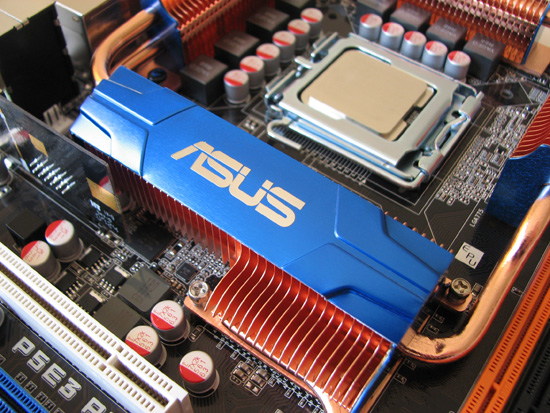
ASUS has managed to create an eye-catching board, from the all-copper cooling solution and the subtle blue tint on the LGA775 socket, to the tasteful expansion slot colors and the black PCB. If appearance is a major factor in your hardware purchases, the P5E3 Premium could be love at first sight; we were certainly impressed by the aesthetic balance. A quick and easy way to distinguish the Premium from the Deluxe (Intel X38 based) variants of the P5E3 series is the deep cobalt blue anodizing on the heatpipe covers and side supports. Although we try not to place too much weight on how a board looks, it's nice that users won't have to compromise with an ugly-but-fast board.
The single-piece heatpipe assembly is entirely capable of controlling Northbridge temperatures, even when pushing the board to its limits. ASUS has improved upon the already impressive mounting system by including screws that do not limit their travel to the point where the heat sink may feel "loose." The portions of the assembly covering the Northbridge and the Southbridge include back plates, a feature that allowed us the ability to ensure optimum heat transfer after we replaced the thermal interface material (TIM) with OCZ Freeze and gave the screws a few extra full turns. The heatsinks located above the power MOSFETs are still attached using plastic pushpins and flimsy metal springs - we would also like to see some black plates for these as hard mounting them would bow the board to the point that some of the components would no longer make proper contact with the heatsinks.
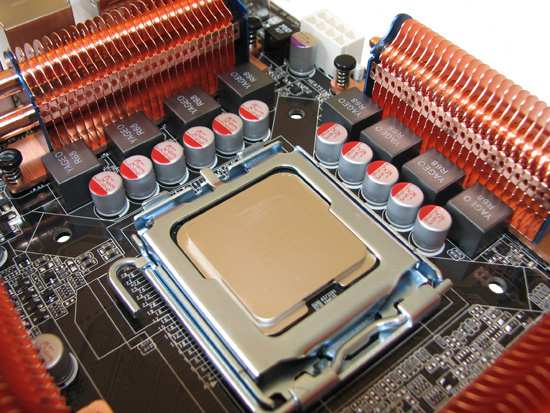
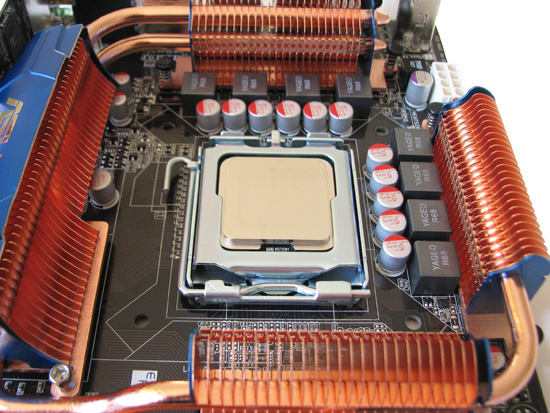
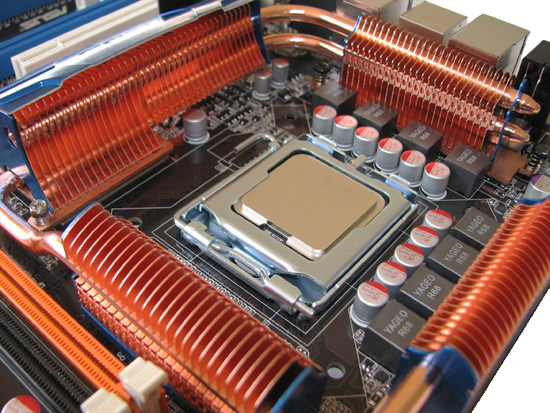
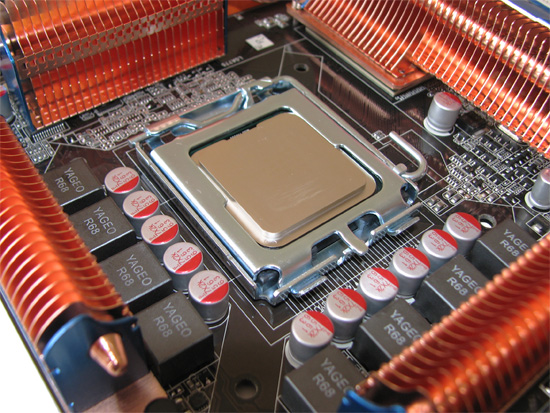
ASUS' power delivery system is among the best in the business at this time. An ADP3228 PWM controller commands an 8-phase solution, made up of low-DCR, solid ferrite-core Yageo inductors, and ultra-low ESR Nichicon capacitors. However, we feel that the two 270uF input power filter capacitors used to remove any ripple in the 12V line coming from the PSU were somewhat undersized for the task. We would like to see capacitors used here which provide at least 2000uF of total supply capacitance. The P5E3 Premium also includes an EPU (Energy Processing Unit), which functions to increase the VRM efficiency 7% by reducing the number of operating phases from eight down to four during periods of light system loading. However, given the incredibly low idle power consumption of Intel 45nm CPUs and G0-step 65nm CPUs, 7% usually works out to rather small savings. Don't expect to see a significant difference in power requirements from this feature alone. Regardless, every bit helps, so we applaud ASUS for their efforts.

Here we can see the familiar trademark of DDR3 memory expansion slots - no on-board termination resistors. As an aside, one of the many improvements included in the change from DDR2 to DDR3 was the movement of motherboard-level termination resistors to the DIMM modules themselves. A closer look at any DDR3 module should reveal the presence of multiple arrays of 4-pack resistor SMDs used to terminate the command and data signal lines as close to the memory dies as possible. Not only does this improve overall signal integrity, allowing for stable operation at much higher memory speeds, but the memory power delivery solution can benefit as well. Fewer discrete components located near the DDR3 expansion slots means routing of power delivery (VDDQ) and ground planes can be made much cleaner - a fact ASUS takes advantage of by slightly widening the channel spacing to allow for the placement of extra bulk capacitance.
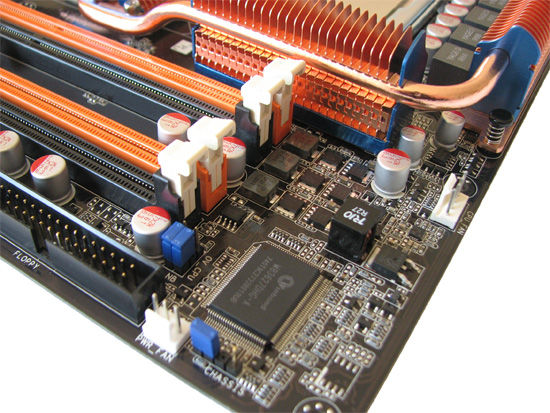
The changes don't end there though. ASUS' new P5E3 Premium is the world's first motherboard to employ a 3-phase memory power solution, shown in the above picture. Out of all the innovations introduced on this motherboard, this was by far one of our favorites. Strong, stable power delivery and solid reference voltages are vital in the success of any memory overclock and this board does not pretend otherwise. Worth noting, we measured the P5E3 Premium as overvolting the memory by about 0.05V with nearly no noticeable droop.
Also seen here are the "OV_CPU" and "OV_NB" jumpers, which select whether or not to allow the use of the higher, secondary voltage ranges available via the BIOS. Most if not all users should find they have no reason to change their positions, as they unlock what we would consider to be ridiculously high voltages. The Winbond SuperIO chip sits at the corner of the board.

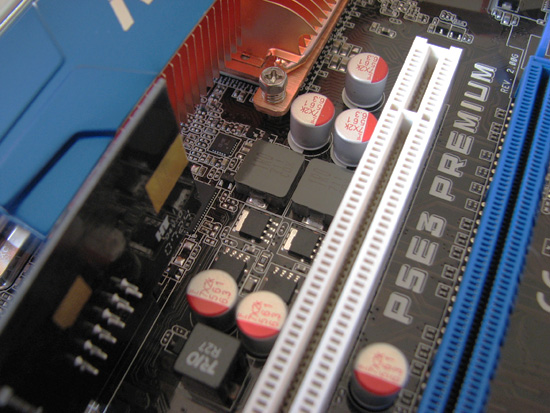
Not wanting to be left out, the Northbridge (MCH) is powered by a robust 2-phase system, something we have already grown to expect when it comes to the high-end X48 motherboards. ASUS' implementation is particularly interesting in that their solution utilizes the same exact MOSFETs used in both the CPU and memory power delivery circuits. Again, a clean, stable power supply is vitally important in any overclocking scenario. Our measurements showed the board overvolting the MCH by about 0.05V with about 0.01V of droop under load.










32 Comments
View All Comments
AllanLim - Wednesday, February 20, 2008 - link
My bad...missed those.AllanLim - Wednesday, February 20, 2008 - link
But I still maintain my position until retail samples show up...squito - Wednesday, February 20, 2008 - link
I can still taste the RDRAM and i820 motherboards ...Orbs - Wednesday, February 20, 2008 - link
The introduction to the article aludes to the fact that in the not-too-distant future, we may have to choose platforms at the expense of component choices such as graphics cards.I think that's already the case and has been for some time. If I want an Intel-based mobo, say goodbye to SLI. If I want SLI, I have to choose nVidia's chipset.
Unless Intel's next platform makes it impossible to choose any graphics card (not multi-card solution, but single-card) then it's no worse than what we have today.
That said, I think we would all welcome the ability to run any two (or three) add-in cards in SLI or CrossFire for graphics and/or physics on any motherboard. That would make it much easier to decide which components to buy as we could judge them on their individual merits and not on what limitations they impose on the rest of the system.
Cykoth - Wednesday, February 20, 2008 - link
You know? This is all well and good....but Anandtech has never completed the review of the Asus Striker II Formula. Based upon the quick blog put out by them, and the feature set, I purchased one for my new build. I had NOTHING but trouble out of it. Even after BIOS updates, extra case fans, and finally an 18Inch fan stuck in the side of the case, it still wouldn't run stabily. I even had problems with the LAN adapters accepting dynamic IP's and therefore no gateway to the internet. Then, no response from ASUS tech support at all. I used to be a HUGE Asus fan....but I've RMA'ed that piece O' crap, and am waiting on my P35 chipset Gigabyte so I can have a system that doesn't REQUIRE water cooling to function.Really Anandtech.....will you EVER complete the Striker II Formula review? I'm interested to know how you got it to work.
Cyko
tmarques - Wednesday, February 20, 2008 - link
The winbond chip is the SuperIO or hardware monitoring chip.The BIOS chip in ASUS new motherboards is, usually, a flash SPI chip, that sits next to the SPI debug connector.
The P5E3 Premium SPI BIOS chip and connector are next to the CMOS battery.
kjboughton - Wednesday, February 20, 2008 - link
Yep, you're absolutely right. Confused the chip with something else. Thank you.RobinBee - Wednesday, February 20, 2008 - link
I see these logos on AnandTech's pictures.These (ASUS) logos must be removed, before using a motherboard.
Does AnandTech test MBs without removing those logos?
If so, a MB's passive cooling is not optimal.
Rajinder Gill - Wednesday, February 20, 2008 - link
The 'Ai Lifestyle' logo is glued onto the Southbridge heatsink block. Even if removed, there are no fins to take advantage of the airflow, other than the slightly reduced thermal resistance - no real gains in removal there.The blue Asus logo plate has a heatpipe passing thru it, via a hole on the left of the Nortbridge heatsink. Meaning one would have to break or cut it, to take it off the heatsink. Obviously, there would be some benefit to removal, but perhaps the benefits of an active warranty are better than 2-3 degrees of temp drop..
We tend only to remove things that are removable by design, in this case neither of those logo plates are designed to be removed.. Hence we have no issue chagning out thermal paste if we deem it necessary.
regards
supremelaw - Wednesday, February 20, 2008 - link
Forgive me if this question reveals my ignoranceon this one point: I obviously need answers,
and still don't have answers ...
As someone who is responsible for keeping several
backup copies of a database up-to-date, I have
found that x4 PCI-Express lanes cause a lower
ceiling on the performance of RAID 0 storage
than x8 PCI-Express lanes in any given expansion
slot.
One of the reasons why we purchased the ASUS
P5W64 WS Professional, is the use of 4 x x16 slots
which can be assigned 8-8-4-8 PCI-Express lanes
(one option mentioned in the User Manual).
The better RAID controllers that we are considering
all require x8 PCI-Express lanes, instead of x4 lanes,
e.g. Areca, Highpoint, etc.
Someone is now going to recommend here that
we forego SLI or Crossfire and use one of the
x16 video slots for the RAID controller.
OK: I don't mind going without dual video cards,
because I don't need to live and work on the
bleeding edge of graphics technology.
BUT ... here's the rub: if you contact Tech Support
at the companies that manufacture RAID controllers,
they are typically unable to confirm if their x8 lane
controllers will work in x16 video slots.
"Try it and tell us what happens," they all say!
If that combination does NOT work, the RAID controller
must be inserted in the only remaining x16 slot,
which only gets x4 PCI-Express lanes, NOT x8!
That combination just proves that such motherboards
were the WRONG CHOICE from day one.
I thought that PCI-Express was designed to provide
greater speed for most peripheral subsystems,
NOT JUST graphics cards.
WHAT GIVES?
Sincerely yours,
/s/ Paul Andrew Mitchell
Webmaster, Supreme Law Library
http://www.supremelaw.org/">http://www.supremelaw.org/